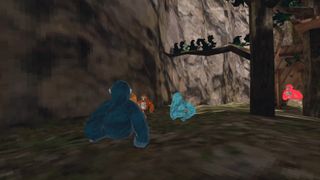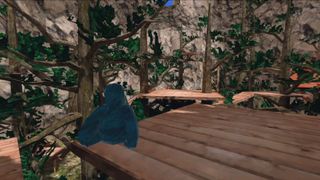Tag has inexplicably become this year's hottest VR game
Gorilla Tag turns you into a high-flying monkey while you chase other players around a jungle playground.
"I was wall climbing and chasing a monkey, got waaay too immersed and full on slammed the shit out of it against a bedside table," says HeyoooWhatsUpBitches, a user from the Gorilla Tag subreddit who smashed their Oculus Quest 2 controller during a particularly intense play session of Gorilla Tag. Take a glance at the subreddit and it's not the only story about a broken controller or injury you'll find about Gorilla Tag, a free VR game that has quickly become one of the VR’s biggest hits.
Another Axiom’s simian simulator has had more than 450,000 unique players since its launch in February, with 3,622 concurrent players recorded across Steam VR and the Oculus Quest in May. This may seem small by general gaming metrics but within the virtual reality ecosystem, these are silverback numbers. For some context, VR’s ubiquitous rhythm slasher Beat Saber has only ever had 4,472 players at one time on Steam.
Why is this free game from a single developer taking over? Gorilla Tag’s main selling point is that it’s deceptively simple (and extremely fun). It's also exactly what it sounds like: A game of tag but everyone is gravity-defying gorillas that can scale the environment.
Monkeying around
I think the locomotion makes you feel much more present in the space since all the movement is embodied by your physical actions.
Once you awkwardly pull yourself out of the cold cave that serves as a tutorial, you’re immediately thrown into a lo-res jungle populated by several human competitors. As the sounds of virtual strife hit your ears, you realise they’re all desperately trying to avoid each other.
That’s because Gorilla Tag is a game of infection, and all you’ve got to survive are the limbs life gave you. One player (or gorilla, in this case) is infected and tasked with tagging other players to spread that infection around.
Climbing from a static position is easy, but there’s no analogue stick for movement. You have to swat down hard with your hands like you’re treading water if you want to get anywhere. As you can imagine, it’s pretty much a full-body workout to maintain your momentum in a high-speed chase.
If you want to get technical, you can wall jump too but it takes a deft touch, as you gently pat each side in sync to bounce between walls and propel yourself upwards. Tree climbing is about as primal as it gets, asking you to slam the air in front of you like you’re Gordon Ramsey putting together an idiot sandwich.
The biggest gaming news, reviews and hardware deals
Keep up to date with the most important stories and the best deals, as picked by the PC Gamer team.
When I first entered the jungle an adept ape spotted me making a fool of myself and swung from the treetops to prod my helpless, legless torso, which turned my dark blue fur into the colour of Flamin’ Hot Cheetos. This is the brand of a loser in Gorilla Tag, confirmation that I hadn’t lasted more than 30 seconds in my first game. Emasculated and alone, this spurred me to take the controls seriously and get good in order to understand virtual reality’s latest frontier.
"I think the locomotion makes you feel much more present in the space since all the movement is embodied by your physical actions, and then you combine that with feeling present with other people," says solo developer Kerestell ‘Lemming’ Smith, trying to explain Gorilla Tag's runaway success. "I think those two things work together extremely well, and it makes it feel much more like you’re co-existing in a common space rather than just playing a video game together."
Smith was a world champion player of Oculus’s zero-gravity Quidditch game Echo Arena before he created Gorilla Tag, so I'm not surprised that the movement is easy to toy with but tricky to master. Understanding why it has become a social hub is another story entirely. Smith recently added a casual queue because players just want to hang out and chat inside of the game without any strict rules.
It sounds absurd, but after getting stuck in the geometry of a slide and making friends by yelling for help, I can confirm that it is quite compelling to have a roundtable discussion with the United Nations of primates in virtual reality. It’s not quite VRChat, but you could, bizarrely, call some of the conversations I’ve had in Gorilla Tag thoughtful. Smith says that some players have racked up more than 100 hours already, "which is impressive considering how tiring it can be."
Yet like many online games, some public lobbies can also be toxic, with screaming kids and slurs ruining the calm atmosphere. Smith is very conscious of this and is fighting back by aggressively grafting moderation tools into the game and wielding a liberal banhammer. "It’s kind of a self-fulfilling prophecy; if a game is viewed as being toxic, then it gains more toxic people, who drive away the good people you want to stay around, who avoid it due to toxicity," Smith says. Recently, he’s started publishing how many players he bans in a day to deter the bad eggs.

There are plenty of good eggs too: the welcoming Gorilla Tag modding Discord (which has a #looking-for-gorilla channel) is closing in on 9,000 members and recently launched the Monke Map Loader in late April. This crossplay add-on allows players to upload and download user-generated play spaces to fool around in, from de_dust2 to the International Space Station. Elsewhere the community has developed a variety of hats and skins as well as a way to write programs for the functional computer found in the in-game treehouse.
Community rep and developer Bobbie says that the promising creative energy behind Gorilla Tag could create a ripple effect throughout the entire VR modding community. "Plenty of people from the Beat Saber community migrated over, and in three months the Gorilla Tag modding community has been able to blow away what VR games usually have in that timeframe."
Another thriving part of the troop is the grassroots esports scene, which has leagues, referees and money on the line for top taggers. "I hopped onto the comp server the week before the league started and asked if they needed a caster," says community leader Josh Albert. "I used to watch a lot of competitive Smash and always wanted to try it."

Albert and the admin team had to create all the league rules from scratch and says that figuring out how to cast a chaotic arena of limber apes has been an interesting process. "Some of the players are so good—it is basically impossible to keep everyone in frame," he says. Matches are hard-fought and full of crafty tags, with death-defying wall jumps and careful branch perches sealing tense matches. A recruitment centre has been established in the competitive Gorilla Tag discord to nurture budding ape athletes into esports starlets.
Being an ex-competitive player, Smith is supportive of Gorilla Tag’s competitive scene and is keen to see it grow from the bottom up rather than the top down. "I think there’s enough meat to the mechanics that you could have a very deep and competitive game come out of it, which is exactly what happened with Echo Arena," Smith explains. "But it’s going to be up to the people to make something out of it."
"I’m still very new to all this, so I’m hesitant to pass anything off as wisdom as opposed to superstition," Smith says.
"That said, what I feel most satisfied about is that I had some very clear ideas for how I think VR should be approached, like grounding the player in a consistent world that has clear rules and removing arbitrary things like floating UI, menus and interactions that aren’t grounded in direct inputs from the player. Applying those rules ended up with something that I think is very fun that other people seem to really enjoy."
Most Popular


